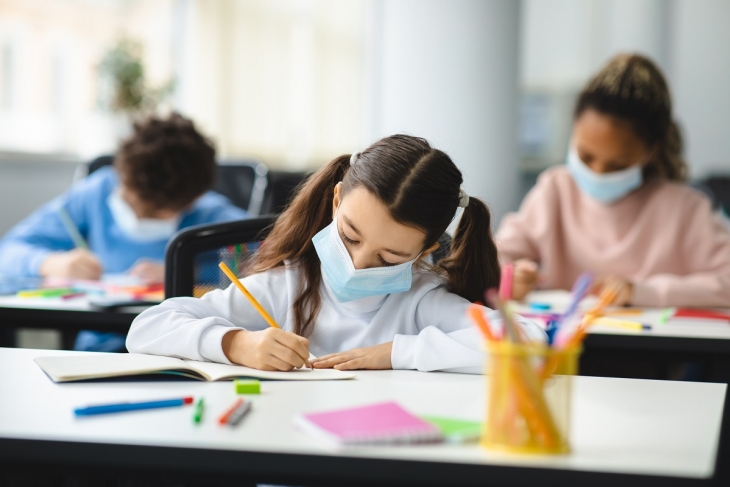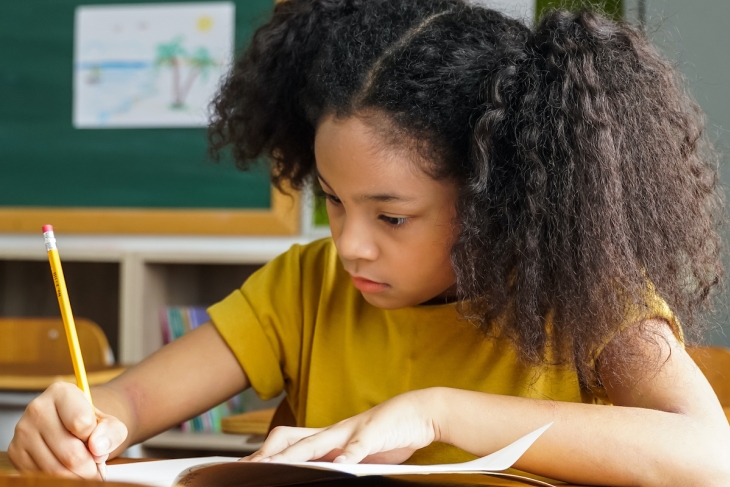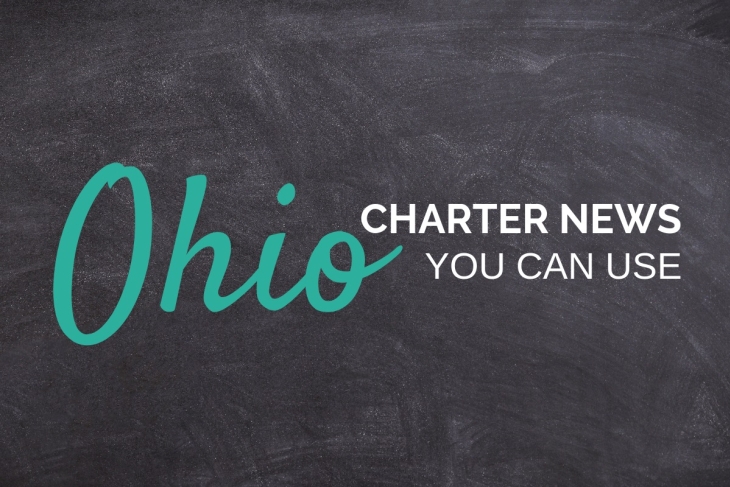- A San Clemente, California, elementary teacher, Kristine Hostetter, marched to the capitol in the January 6 Trump rally that preceded the riot. Her school split over whether to suspend her. —New York Times
- U.S. Secretary of Education Cardona: “Schools need to rebuild trust with students and families of color as reopening continues.” —Chalkbeat
- Dallas schools are staffing in-school suspension classrooms with personnel trained in mental health supports to address equity issues in discipline outcomes. —Dallas Morning News
- How parents can cultivate creativity in children. —Daniel Willingham
- Box Tops for Education switched to an app, scrapping the fun and simplicity of collecting cereals boxes and drastically reducing the funds raised for schools. —The Atlantic
Cheers
- Standardized testing helps ensure that schools are transparent and equitable for students of color. —Marc Morial and Janet Murguía
- Parents praise Andrew Yang’s push for school reopening, his support for charters, and defense of selective admission to gifted programs. —The 74
- New Orleans transformed public education and expanded school choice for all students in the aftermath of Hurricane Katrina. Let’s embrace similar reforms in the wake of the Covid crisis. —Bobby Jindal and Joe Ricketts
- The pandemic created new ways to train and employ those without four-year degrees. —Bruno Manno
- How New York City can better integrate schools and serve communities of color. —Eva Moskowitz
- Manhattan teacher Paul Rossi is standing up to indoctrination for his students’ sake. —Common Sense with Bari Weiss
- “How two Cleveland schools stayed open through the pandemic with few Covid cases and more learning opportunities” —The 74
Jeers
- “Anti-poverty group flunks lawmakers for blocking Harlem charter school.” —New York Post
- After the Espinoza U.S. Supreme Court ruling, public funds may go towards teaching problematic curricula. Some wrongly believe that it’s therefore best to cut off all such monies to charter and private schools. —USA Today
- Some blue state leaders opposed reopening schools because they opposed Donald Trump—committing what may be the most “significant failure of public policy in a generation.” —Paymon Rouhanifard
- We start out today with a great, in-depth look back at this school year as experienced in two inner-city schools in Cleveland—one Catholic, one charter—which have both been open for fully in-person learning since August. Sounds like it all went about as well as it possibly could, thus providing your periodic reminder (with a pandemic twist) that we’ve got choices here in Ohio, people. Especially in our cities. Use ‘em if you need ‘em! (The74 Million, 4/14/21)
- In up-to-the-minute news: State testing has begun in a number of Springfield-area school districts. No word on how it’s going, unfortunately. (Springfield News-Sun, 4/14/21) Progress toward graduation is going great for seniors in central Ohio, it seems, with many districts crediting pandemic-mitigation graduation requirement changes for putting them on course for Hundo P. (ABC6 News, Columbus, 4/12/21) Meanwhile, in Solon City Schools, traditionally one of the highest-performing districts in the state, the school year has been going great and the superintendent says he expects their state test scores and graduation numbers to speak for themselves. Again. (Cleveland.com, 4/12/21) Sounds like a similar story in Fulton County in far northwestern Ohio. Districts there seem unfazed by…well, anything that has gone on the last year. Even though some of their staffers express the usual dislike of standardized testing, those same folks say outright that even the minimal testing flexibilities in place—hard won by legislators and advocates during the debate over HB 67 (you know what I mean)—are not needed by their students in order to show what they know. They will simply take the tests and move on. (Fulton County Expositor, 4/13/21)
- Looking forward to the end of the school year, here’s a look at summer offerings planned in Youngstown City Schools…with a side of Mohip-bashing for old-old-times’ sake. Registration deadline for all the academics, music, fun, and more is today. (Vindy.com, 4/12/21) Not much detail on Toledo City Schools’ summer programming. Mainly because it appears that what will be offered during those four weeks will be based on who’s planning to show up. Parents and guardians have until April 30 to tell the district what they want them to provide for their kids. Courses will be built from those responses with registration for all opening in May. (Toledo Blade, 4/12/21) Not interested in a choose-your-own adventure this summer? The application window for the Toledo Museum of Art’s already-created summer courses is open right now. With scholarships available. (13ABC News, Toledo, 4/14/21)
- Looking a bit farther into the future, the odyssey of the Cupp-Patterson plan, which would revamp school funding in Ohio into the far future, took another turn this week when the current iteration of that plan was subsumed into the state budget bill currently under debate in the House of Representatives. That revised bill also included a few other education-related provisions noted here. (Cleveland.com, 4/13/21)
Did you know you can have every edition of Gadfly Bites sent directly to your Inbox? Subscribe by clicking here.
In the song “Ballad of a Thin Man,” Nobel Laureate Bob Dylan penned an iconic refrain that asks: “But something is happening/And ya’ don’t know what it is/Do you, Mister Jones?” That refrain seems an apt way to describe what K–12 education stakeholders are sensing as they reel in response to Covid-19 shock.
The thoughts and reactions of teens and parents to the pandemic are a good place to begin to gauge front-line consumer reactions and get a glimpse of what might come next. So let’s examine what the nation’s teenagers say about how they’re doing emotionally and educationally after a year of Covid-19—and what parents are saying and doing about their child’s education.
In general, teens report that, though school related issues have improved, their health and happiness have declined. They’re hoping not to return to the “old normal” at school next year. Meanwhile, parent dissatisfaction with how schools have responded to the pandemic is growing, and they’re choosing different options for educating and supporting their children.
The information on teens is based on a February 2021 survey conducted by Morning Consult for EdChoice and a November 2020 Gallup poll. The adult perspectives are based on U.S. Census Data and surveys conducted by Gallup last summer, MassINC Polling Group in the fall, and Education Next over the winter. More specific takeaways are explored below.
The Morning Consult poll queried a nationally representative of one thousand teens aged thirteen to seventeen, and was a follow-up of a similar survey in August 2020. It had five key findings.
First, teens report their health, happiness, and relationships decreased since the pandemic began. More than half report their stress (63 percent), motivation (54 percent), anxiety (53 percent), and mental health (51 percent) have worsened. They’re also more likely to say that their happiness, friendships, family finances, and physical health have deteriorated. When asked to express “what three words best describe how you feel about school right now,” the top five emotions were stressed, bored, stressful, tired, and unmotivated.
Female and White students were more likely to report declining mental health. Those learning either partially or completely online were three times more likely to report declines than those fully attending school.
The one area where the situation has either stayed the same (41 percent) or gotten “somewhat” or “much better” (32 percent) is relationships with their immediate family.
Second, concern about the pandemic is lower now than at the beginning of the school year, though is still high. From August 2020 to March 2021, the share of teens reporting some level of concern about the pandemic decreased from 81 percent to 72 percent. That decrease was primarily among those feeling “very concerned,” dropping from 39 percent to 31 percent. And those indicating they are “not that concerned” or “not at all concerned” decreased from 17 percent to 14 percent.
Third, teens attending school in person full time report being more positive about their education this year than those mixing in person and online learning or those completely online. Eight in ten full time attenders (80 percent) say school is going “somewhat” or “very well,” compared to slightly more than six in ten who are combining in person and online (64 percent) or those completely online (63 percent). And more than four in ten (44 percent) of those full-time attendees fall in the “very well” camp, double those in each of the other two categories (18 percent for in person and online and 22 percent for completely online).
Fourth, when it comes to implementing mask-wearing policies, nearly six in ten (57 percent) full- or part-time school attendees rate school as “above average” or “excellent.” Commenting on other safeguards taken in schools, only slightly more than three in ten rate their school as “above average” or “excellent” when it comes to “installing physical barriers such as plexiglass” (27 percent) or implementing “six feet [social distancing] policies” (27 percent).
Full- or part-time school attendees also report having more resources today than they did in August 2020, including access to teachers, a quiet place to study, and to the internet, computers, or similar devices for schoolwork, with all of these improving by at least 9 percentage points.
Fifth, more than nine in ten (93 percent) say they should have at least some say in the type of school they attend, and many prefer a mix of in-person and online education more than spending five days a week in either setting. A plurality of more than four in ten (44 percent) say that, after the pandemic, they prefer schooling that includes both in-person and online learning, with only one in three (34 percent) saying they want to return to in-person, full-time school.
The November 2020 survey conducted by Gallop reinforces many of these findings. Supported by The Barr Foundation, it involved one thousand high school students. It found that large majorities are deeply unsatisfied with their academic experience, feel behind academically, and are disengaged from teachers, peers, and coursework. For example, less than two in ten say they “learn a lot every day” (18 percent) and are “excited about what I’m learning” (17 percent), down from pre-pandemic levels.
Pandemic shock is also affecting parents. The summer 2020 Gallup poll reports that the proportion of parents saying they were “completely satisfied” with public schools going into the 2020 school year dropped 9 percentage points from the prior year, to 32 percent from 41 percent.
This dissatisfaction is driving some of them to vote with their feet, withdrawing—or not enrolling—their children in schools. Gallup further reports that parents homeschooling their child almost doubled, to 10 percent from around 5 percent. And those enrolling their child in a public school decreased 7 percentage points, to 76 percent from 83 percent.
The homeschooling number is reinforced by new data from the U.S. Census. It also found homeschooling increased, to 11 percent of households from 5 percent, even after a clarification was added to the question to ensure households were reporting true homeschooling rather than virtual learning through a public or private school.
The Education Next survey also found shifts away from traditional district-run public schools, including a decline in district public school enrollment to 72 percent of students from 81 percent between the spring and fall of 2020. It also found an increase in homeschooling to 8 percent from 6 percent, along with increases in private school and charter enrollments. Though the increases were too small to be statistically significant, they track with the other surveys.
As for the MassINC Polling Group, it was also supported by The Barr Foundation and surveyed 1,549 parents of school age children in October 2020. Around half of parents say there is a range of negative impacts on their children, including academic learning (52 percent), mental and emotional health (49 percent), opportunities for friendship (58 percent), and social and behavioral skills (49 percent). Almost three in ten (28 percent) see their children falling behind grade level compared to a previous survey in May 2020, when around two in ten (22 percent) said the same. Those parents who enrolled their children in different schools or a learning pod or hired special tutoring assistance reported more positive feelings about all these issues.
How much of this will “stick” beyond the pandemic? No one knows for sure. But it seems reasonable to bet that some will. For example, an NPR/Ipsos national poll found that almost three in ten (29 percent) parents are likely to continue with remote learning indefinitely. That included about half of the parents who are currently doing it.
Indeed, school district leaders sense change is underway, and some are responding to give students and parents more options than the “old normal.” A RAND Corporation analysis of a survey from their new American School District Panel, which consists of leaders of more than 375 school districts and charter management organizations, found that about one in five are considering a remote school option after the end of the pandemic. For example, Cobb County in Georgia serves more than 112,000 students. It’s the second largest district in the state and twenty-third largest in the nation. Superintendent Chris Ragsdale announced that the district would enact a classroom choice program for the 2021 school year. The online learning will be supported through Cobb Online Learning Academy along with Cobb Horizon Academy and Cobb Virtual Academy.
Covid-19 school shock has dismayed young people and their parents. So something is happening. And we don’t know what it is entirely. But we do know it has catalyzed their determination to respond in new ways. Our best hope is that our emergence from the pandemic positions them for what could be a new era in educational excellence, one in which families have more direct control over, and options for, their child’s education. One that gives our children an effective education that prepares them for opportunity and success.
Although most schools have returned to some semblance of in-person learning for families who want it, education researchers and analysts are still working to gauge the impact of extended school closures. A recently published research brief from Curriculum Associates takes a closer look at unfinished learning, another term for “learning loss.”
Using i-Ready’s criterion-referenced, grade-level placement tests, analysts compared student achievement during winter 2020–21 to the achievement expected during a typical school year. Students were asked to report whether they took the test in school or out, allowing researchers to disaggregate data based on testing location. The results from in-school assessments proved to be the closest to a “true” comparison of prior year performance, as the testing location was more consistent with historical conditions and the results were less variable from student to student. As such, the results reported in this brief cover only in-school assessment data—an important limitation given how many students are still learning at home full-time.
The sample includes students in grades one through eight who took the midyear diagnostic assessment during the winter of the 2020–21 school year. It comprises nearly 1,160,000 students for reading and more than 1,291,000 for math. Students from forty-nine states and the District of Columbia are represented, though the number of students is not statistically representative of any state. To compare winter results to prior years, the researchers constructed a historical average to represent typical performance during the three previous school years. They also matched student data at the school level to ensure that current and historical samples consisted of students in the same school, and school demographic data were obtained from the National Center for Education Statistics.
i-Ready assessments provide teachers and parents with grade-level placements that are relative to a student’s chronological grade level. Based on a student’s performance, they could be designated as on, below, or above grade level. For the purposes of this paper, students who were designated “Early On Grade Level” or higher are considered on grade level, which means they have partially met grade-level college and career readiness standards. They are referred to as students who are ready for grade-level work. Students who were designated “Two or More Grade Levels Below” are considered below grade level, which means they aren’t yet close to meeting college and career readiness standards. They are referred to as students who are underprepared for grade level work. The researchers differentiate between these two groups—students who are on grade level and those who are below—throughout the brief, as they observed slightly different patterns when examining the demographic data.
Overall, the findings indicate that unfinished learning was greater this winter in both reading and math compared to historical averages. In reading, the percentage of students considered ready for grade-level content decreased across all grades, with a particularly strong decline in grades one through three. The percentage of students who were underprepared for grade-level reading content also increased. Math results are similar. The percentage of students considered prepared for grade-level content decreased during the 2020–21 school year, with students in grades one through six demonstrating the largest amount of unfinished learning. The percentage of students who were underprepared for grade-level math content also swelled, with students in grades two through six showing the greatest increases. In both subjects, the youngest students appear to have suffered the most from school closures.
Unfinished learning was greater for students who attend schools serving a majority of Black or Latino students, although it is important to note these results rely on school-level demographics, which do not capture diversity within a school or variability within a school’s demographic groups. For this finding, the researchers focus on third grade results, as it is a “pivotal year” that research indicates is predictive of high school outcomes. Across the board and compared to historical averages, the percentage of third graders who were ready for grade-level work decreased in both reading and math. These declines were similar across groups and within each subject. There are, however, notable differences in which students were impacted. In reading, there is a greater increase in unfinished learning among those who attend schools serving a majority of Black and Latino students compared to schools with a majority White population. The results are similar in math, where unfinished learning was greater for schools that serve a majority of Black or Latino students compared to majority White schools.
Unfinished learning was also greater for students who attend schools located in lower-income areas. The researchers disaggregated data based on the median annual household income associated with a school’s zip code. They found that the percentage of students who are considered ready for grade-level content decreased regardless of income bracket and across grade levels and subjects. However, in reading, the decline among third graders was slightly less for students who attend schools in zip codes where the median income is greater than $75,000. Similarly, although the percentage of third graders who are underprepared for grade-level content increased regardless of income bracket, the changes were steeper for students who attend schools located in zip codes with an annual median income below $50,000. In layman’s terms, kids from lower income areas were less likely to be ready and more likely to be underprepared for grade-level reading content. The same proved true for math.
It’s still too early to determine empirically whether students have caught up after starting behind this fall. But the researchers took a look at changes in grade-level placements for a sample of students who took the i-Ready diagnostic during both the fall and winter testing windows to see if any patterns emerged. They found that in some subjects and grade levels, the difference between the historical average and the current school year increased, while in others it decreased. This particular finding must be interpreted with caution due to sample constraints, but it appears that the variability across subjects and grades makes the midyear results inconclusive as far as whether students are catching up.
The brief closes with several recommendations for addressing the “persistent and significant” challenges of unfinished learning. These include ensuring assessments deliver clear and actionable data, choosing high-quality and rigorous curricula that focus on grade-level work and addressing learning gaps as needed, setting ambitious yet attainable goals for students, and prioritizing coherence to avoid redundancy. These strategies and more will be desperately needed to address the unfinished learning identified in this report—and the even greater gaps that have likely opened up for students who haven’t set foot in classrooms in over a year and weren’t part of this particular analysis.
Source: “What We’ve Learned about Unfinished Learning,” Curriculum Associates (March 2021).
- The editors at Vindy.com seem preoccupied with Ohio’s lowly ranking in a recent WalletHub report on return on taxpayer investment in education. So much so that they are siding with the dinosaurs that gave us the DeRolph school funding case approximately 66 million years ago. They opine that if Ohio doesn’t enact the current funding overhaul bill, the WalletHub rating should encourage folks to move to a “better state”. So it’s literally their way or the highway? (Vindy.com, 4/12/12)
- As if that wasn’t enough incentive to get you thinking of leaving the Buckeye State behind, how about this: Today Wooster, tomorrow the world! Not content with Zoom, the College of Wooster has actually placed nine mobile “virtual presence devices” (y’all saw that episode of Big Bang Theory, right?) in Wooster City Schools so that their student teachers can actually “circulate around the room” and talk with various kids during the day. Just like normal. We don’t know how much those things cost but I’m sure the return on investment would be worth a look. (News5, Cleveland, 4/9/21)
- Utica Shale Academy is deep into VR already, and looking to buy another “virtual welder” for its students to train on. That’s just one of the many expansion ideas on the books for the burgeoning charter school in southeastern Ohio. (Salem News, 4/9/21)
- If you do decide to stick around Ohio after all, here are three possibilities of what your school’s annual report card might look like in the near future. While the first two are fairly standard—and well-discussed around here already—the third one noted at the end of this piece seems like the best option to include “number of robots” and “return on investment” as school quality measures. Or perhaps we could just let WalletHub rate our schools from here on out. (Dayton Daily News, 4/10/21)
Did you know you can have every edition of Gadfly Bites sent directly to your Inbox? Subscribe by clicking here.
This fall, most students will be returning to full-time, in-person instruction after one of the most disrupted years of their lives. All students will be coming back with varying degrees of adverse experiences. Some may have lost loved ones, had a parent lose their job, seen a parent go through illness, or even been sick themselves. And all students will have experienced a disruption to what their “norm” was prior to Covid-19.
Though the data are still being gathered on the exact mental health toll the pandemic has taken on children and adolescents, both the initial numbers and anecdotal experience suggest a significant impact. A recent CDC report found that pediatric emergency department visits for mental health from March 2020 to October 2020 increased over their 2019 comparisons by 24 percent for children ages five to eleven and 31 percent for adolescents ages twelve to seventeen. This comes at the same time that overall emergency visits for this same population during the same time period were down by 43 percent.
Schools, school leaders, and teachers are going to return to an environment they have never seen before. A significant emphasis has been placed on trying to figure out how to mitigate learning loss, but schools must remember that they can’t begin to mitigate that loss until they help students stabilize their mental health.
Mental health options for schools to consider
A strong mental health program should offer a diverse array of services and be tied into every aspect of the school day. As schools prepare for students to return, they should consider mental health services outside the traditional one-on-one counseling most of us think of when discussing mental health. A few specific considerations are listed below.
Safety planning for suicide prevention. Evidence on youth suicide rates during the pandemic is still mostly anecdotal, but suicide was the second-leading cause of death among adolescents before the virus hit. Schools can address this need by ensuring that they have a strong process in place for identifying and evaluating students for suicide or self-harm risk and for working with them and their families to create and implement a safety plan when a risk is found.
To correctly identify students who are at-risk for suicide, schools must do comprehensive training for all staff members—not just teachers—on how to look for risk signs and what to do if they find them. This training should take place during summer professional development, but it should also be an ongoing topic throughout the year.
Once a staff member has identified a student who they believe may be at risk, they must know exactly what to do and where to take them for an evaluation. Schools should have a set process to evaluate student risk and a clear plan of what to do if the student is an immediate risk to themself or others, such as going to the hospital immediately, or is not a current active risk but may be at some point, like creating a safety plan.
A good safety plan should help students and the people around them identify potential triggers for self-harming behavior and have places to go, people to speak to, and emergency numbers to call if a student feels unsafe. Every school should have a template for a safety plan. Even if schools don’t have mental health professionals on staff, they should still have a concrete safety planning process in place, and all staff should be able to confidently discuss it with a student.
In preparation for a return in the fall, all schools should take time this summer to review their plans and update them to reflect the change coming—for example, how to provide support to students who may need to remain virtual because of health concerns.
Group therapy. Well-done groups are one of the most effective therapeutic techniques for schools. They not only help students address common mental health concerns, but also facilitate interpersonal social-emotional growth. From an organizational perspective, groups allow one mental health professional to serve multiple students in a shorter amount of time. As schools get ready to transition back to more traditional classroom learning, they should consider where and how to integrate groups into the school day.
After having experienced similar levels of life disruption caused by virtual or hybrid learning, many students will return with shared mental health concerns. Potential Covid-related group topics include grief for students who have lost family and friends to the pandemic, germaphobia and compulsive tendencies for students who have internalized hand washing and mask wearing to the extreme, and sensory issues for students who are struggling to return to large and busy classrooms after potentially more than a year of learning individually in their rooms.
One way schools can consider adding groups into the school day is by integrating them as a class during traditional elective time. This can be an opt-in choice for families who already know their students need this support or a recommendation from the school after an initial evaluation. Another option for schools with flexibility in the schedule before or after school would be to add optional groups on site during those times for families who opt in. They should also be mindful of the quality of the provider. This is important to all mental health services, but is particularly essential in groups. While a well-run group is extremely effective, a poorly run one can be ineffective or harmful.
Schools with highly qualified mental health staff can wrap this into their normal work. But those without these faculty in place should consider using federal pandemic aid dollars to hire strong mental health professionals to run these groups. As they can serve multiple students at one time, this can be both a strong therapeutic option, and a cost-effective one.
Coping skills for overstimulated students. When students return in the fall, some will not have been in a regular classroom for more than a year. Their daily routine went from one that was surrounded by people, activity, and sensory overload to one that was predominantly just their families. Going back will be over-stimulating for many.
Schools should consider having mental health professionals in place to support these students, as well as having the tangible tools to help them cope on campus. Some examples are headphones, music options, and systems in place that allow students to take a break from excessively stimulating environments, such as quiet rooms.
For students who display more severe symptoms, individual plans should be created to help them ease back into the school environment. These services are best provided by a qualified mental health professional, for which schools can use stimulus funds.
Universal screening tool. We can’t know students’ current ability or what they need without assessing them. Mental health is no different. All schools should have a universal screening tool in place that can evaluate all students before or immediately after the beginning of the year for whether they require these services.
Keep in mind, however, that these screening tools can do more harm than good if schools do not follow up with services. If a screening shows that a student needs support for depression or anxiety, for example, but the school does not then provide that service, the student learns that being vulnerable and asking for mental health support does not mean that that support will come.
Many states have a universal screener recommended by their department of education, but if your state does not, some examples include The Strengths and Difficulties Questionnaire or The BASC-3. Each school should customize the screener to their particular needs and have a plan and the resources in place to address any needs that are discovered. Federal aid dollars can be used both for the development of this tool and for the mental health professionals required to provide the services needed.
Students of Concern team. Although a universal screening tool is helpful in identifying issues upfront, ongoing observation and assessment are needed to both ensure strong treatment is occurring and to identify students whose needs did not appear on the initial screening. A weekly Students of Concern (SOC) team meeting can be an effective way to address these concerns. These are holistic groups made up of experts in students’ academic, physical health, mental health, behavioral, special education, and any other unique school needs. They should meet weekly, with a plan for which students to discuss and evaluate. Each team member should leave these meetings with concrete follow-up assignments designed to meet each student’s unique needs. And any staff member, student, or parent should be able to refer a student to the team for consideration.
This approach can help ensure that the students with the highest needs are consistently being supported and that their support plan evolves as their needs do. Schools can consider using federal stimulus funds for support staff members to ensure teams’ goals are met.
Mental health support for staff. Just as students have experienced a drastic change in the school environment, so too have school staff members. One of the greatest determinants of a student’s classroom success is the strength of the teacher. As such, schools should consider what supports they can put in for educators. Weekly or biweekly mental health check-ins for staff can provide a huge benefit. For schools that already have mental health professionally, if these individuals have set strong boundaries with their colleagues, they can be used to support the staff. For schools without this resource, consider using federal relief dollars to hire contract mental health professionals for this purpose.
—
As with all mental health, it is important to remember that the quality of the provider is critical to the well-being of students. When hiring, schools should be sure to find licensed professionals and check with state accreditation boards to ensure candidates are in good standing. Possible provider types include licensed psychologists, licensed clinical social workers (LCSW), licensed master social workers (LMSW), and licensed professional counselors (LPC). Keep in mind, too, that school mental health is its own subset of mental health, and not all individuals are prepared for what it requires.
Schools should also be clear about the expectations for student services and any limitations they would put in place—for example, that students not be pulled from core classes. For schools considering partnering with outside providers, particularly companies as opposed to individuals, clarify who will be providing services to students. Many behavioral health companies have a licensed professional to do the initial assessments, but then use unlicensed individuals to implement the actual therapeutic plans. There are certainly times where this could be effective, but mental health can be complex, and the vast majority of services should be provided by licensed professionals.
Access to mental health services is critical to student success in school. With students returning after a year of disruption, these services are going to be more important than ever. Fortunately, federal pandemic aid can help fund these resources in the short term. And if leaders make the most of this opportunity, it can be a profound turning point for mental health access in schools.
Editor’s note: The Thomas B. Fordham Institute recently launched “The Acceleration Imperative,” an open-source, evidence-based resource designed to aid instructional leaders’ efforts to address the enormous challenges faced by their students, families, teachers, and staff over the past year. It comprises four chapters split into nineteen individual topics. Over the coming weeks, we will publish each of these as a standalone blog post. This is the fifth. Read the first, second, third, and fourth.
Family engagement has always been critical to student success, but never more so than now. In the current pandemic, many families have been through significant trauma, from illness, losing loved ones, financial hardship, or losing a job or a home. And of course, many children have been away from classrooms for over a year. Schools and families will need to rebuild in-person connections and shore up trust—first, so parents can feel secure in sending children back to school buildings full time, and second, so families can support educators’ efforts to accelerate student learning. Some of the digital tools that schools and families have put in place to keep connected over the last year can help.
Recommendations
- Regularly communicate to parents and caregivers expectations for student attendance, behavior, and grade-level academic performance—and why these are important factors in children’s development and success as adults. In addition, share the concrete steps the school or district is taking to support students to meet these expectations and make up for pandemic-related learning losses, particularly how families can support these efforts at home. Accessible forms of communication like text messages can build trust and “nudge” families, to the benefit of students.
- Work to build or rebuild trust at the system level, including by soliciting families’ goals for their children and including those goals in program planning. Many of the least-connected parents already distrusted schools before the pandemic, given their own negative experiences with schools or other institutions. Publicly listening and acting on family priorities is one way to build trust, such as by surveying families and publicly sharing how those responses inform decision-making.
- Open two-way lines of communication between parents and teachers and prioritize staff time to maintain them. Family engagement cannot be seen as something “done” to families. True engagement is mutual and relies on open and frequent communication about what’s working and what’s not, with students’ needs at the center. Successful tactics can include arranging regular “office hours” when families can contact staff for any reason, scheduling regular virtual parent-teacher conferences, and stepped-up outreach efforts by school counselors to check in with families about their needs and expectations.
- Work with community service providers to anticipate and respond flexibly to a variety of family needs, including social-service and mental-health supports. And partner with expert organizations to support highly effective instruction using high-quality curricula.
Rationale
School disconnection has played out differently for different families during the pandemic. While some families gained insights as daily instruction played out over Zoom, even the most engaged students have experienced some degree of physical isolation from school environments, and the least engaged students have experienced no schooling at all.
Understanding the cultural factors that shape families’ immediate concerns and priorities is important. Schools and families can more easily agree on short-term objectives, like daily attendance, homework, and reading, when they are connected to a shared goal of a meaningful future for students.
A 2016 report by the Pacific Regional Education Lab suggests that two-way communication that includes frequent data sharing with parents about children’s general academic progress, including both formative and summative assessment scores, has a particularly high impact on students’ academic success. These positive impacts are enhanced when schools ask families about students’ interests, behaviors, and challenges. For example, a 2019 study out of Germany found evidence that frequent communication between schools and families, wherein schools share data on students’ homework completion on a recurrent basis, can increase students’ completion of homework assignments. The study found that simply assigning homework without a strong and sustained school-family relationship did not result in high homework completion rates.
Though there is some debate over the value of homework, especially in the younger grades, we know that well-designed homework assignments are beneficial to students and can communicate with parents what their children are learning at school, particularly when teachers review assignments and offer clear feedback. In addition, reading at home for at least twenty minutes a day has significant academic benefits. A compelling 2020 longitudinal study from the Oxford Review of Education found significant academic benefits correlated with students reading at home, but only when the materials read are books and not other printed materials, such as comics or newspapers. Schools should therefore consider ways to provide low-income families with books.
Finally, both families and schools have a role to play in reducing student absenteeism. A 2007 study from the Mailman School of Public Health at Columbia University points to the devastating academic costs of chronic absenteeism. Chronically absent students score 5 percent lower, on average, on math and reading standardized assessments compared to their peers.
In short, family engagement should be based on principles of transparency and mutual trust, as articulated in the following delineation of roles and responsibilities:
|
CORE PRINCIPLE |
ROLE OF THE SCHOOL |
ROLE OF FAMILIES |
|
Respect for Families and their Cultures: The heart of family engagement is trust, and that means building real relationships. |
Find concrete ways for the principal and classroom teachers to know students, their families, and their cultures. |
Participate in school events, both the academically-oriented ones, like “back to school night,” and ones intended to build community and celebrate cultures. |
|
Attendance and Readiness: Students make the most academic and social-emotional progress when they have enough sleep and are present every day. |
Provide rigorous and engaging lessons that start on time every day. Offer social supports to families if attendance and readiness are significant challenges. |
To the extent possible, ensure that students get enough sleep and arrive at school on time every day. Take advantage of supports offered by the school to ensure their child’s academic success. |
|
Homework: The daily completion of aligned homework assignments supports students’ mastery of the school’s rigorous curriculum. |
Assign meaningful homework assignments that support students’ mastery of the curriculum. |
Ensure that students complete their homework every day and bring it to school. |
|
Reading: Students need a high-quality curriculum and should read independently for at least 30 minutes every day. |
Implement a robust, research-backed ELA curriculum in school and make concrete, low-cost recommendations for texts to read at home. |
Read to young children every day. Ensure that older students read for at least 30 minutes per day. |
|
Screen Time: Excessive screen time can create attention challenges for young children and keeps them from moving their bodies. |
Provide concrete, realistic suggestions for how families can set and enforce screen-time limits while children are not at school. |
Set and enforce screen-time limits and steer children toward reading, exercise, and play instead. |
|
Active Communication: Students’ success in school is dependent on parents and teachers routinely and actively communicating with each other. |
Share routine academic performance updates with families on at least a weekly basis, in families’ preferred languages. Solicit families’ feedback via regular, valid, and reliable surveys. |
Actively communicate with their child’s teacher, including reading all emails and texts that come from the school. Offer feedback proactively or via surveys. |
Reading List
Dettmers, S., Yotyodying, S., and Jonkmann, K. (2019). Antecedents and Outcomes of Parental Homework Involvement: How Do Family-School Partnerships Affect Parental Homework Involvement and Student Outcomes? Frontiers in Psychology. 10.
- Simply assigning a lot of homework does not necessarily lead to its being completed. Robust family engagement (family-school partnerships in a German context) leads to improved homework completion.
Garcia, M.E., Frunzi, K., Dean, C.B., Flores, N., & Miler, K.B. (2016). “Toolkit of resources for engaging families and the community as partners in education. Part 4: Engaging all in data conversations.” Washington, D.C.: U.S. Department of Education, Institute of Education Sciences, National Center for Education Evaluation and Regional Assistance, Regional Educational Laboratory Pacific.
- Speaks to the importance of sharing data with families about how their children are doing in a meaningful way as a key part of a family engagement strategy.
Hill, N., Liang, B., Price, M., Polk, W., Perella, J., and Savitz‐Romer, M. (2018). Envisioning a meaningful future and academic engagement: The role of parenting practices and school‐based relationships. Psychology and the Schools, 55(6), 595-608.
Jerrim, J., Lopez-Agudo, L., and Gutiérrez, O. (2020). Does it matter what children read? New evidence using longitudinal census data from Spain. Oxford Review of Education. 46(5), 515-533.
- It’s widely stated that reading every day is essential for kids’ literacy development. This longitudinal study makes the compelling case that this is only the case when students read books and not other printed material.
Pondiscio, R. (2019). How the Other Half Learns: Equality, Excellence, and the Battle Over School Choice. Avery.
- Points to the important role of being transparent and direct with parents, among other successful aspects of Success Academies Charter Schools.
Romero, M., and Lee, Y. (2010). “A National Portrait of Chronic Absenteeism in the Early Grades.” New York, N.Y.: National Center for Children in Poverty, Columbia University.
- Confirms the detrimental effects of chronic absenteeism in elementary school on school success by examining children from across various incomes and race/ethnicity groups in a nationally representative sample of children entering kindergarten.
Sharkey, P. (2010). The acute effect of local homicides on children's cognitive performance. Proceedings of the National Academy of Sciences, 107(26), 11733-11738.
Sheldon, S. (2007). Improving student attendance with school, family, and community partnerships. Journal of Educational Research, 100(5), 267-275.
- A robust family engagement strategy plays a key role in improving attendance.
The Biden administration recently approved Colorado’s request to ease the burden of administering state assessments because of the pandemic. The state’s application had far more to do with health and safety, proctoring logistics, and a political détente between testing advocates and opponents than anything pedagogical. But its approval may end up unwittingly creating a blueprint for policies that can help overcome a challenge far thornier than test administration—addressing learning loss in math.
Colorado’s plan calls for students in third through eighth grade to alternate taking a summative assessment in English language arts and math each year. This spring, students in the third, fifth, and seventh grades will take the ELA test, and those in the fourth, sixth, and eighth will take the math test. This approach allowed for the preservation of key assessment-related guardrails while taking into account the profound disruptions that students experienced this year.
This only applies to the spring of 2021, but a long-term testing regimen that is divorced from the annual school-year cycle would open up one of the most essential ingredients to addressing math learning loss—multi-year learning progressions.
In almost all middle schools, students are taught math through a single-year learning progression. Teachers focus their instruction on forty to fifty math skills a year—from multiplying fractions to surface area to standard deviations—depending on the grade level they are assigned to.
Single year progressions work fine for students who consistently stay on grade level. But many don’t. In fact, the majority middle school students were performing below grade level before the pandemic. For them, learning gaps from earlier years continued to accumulate, since the concepts they missed in one year were often foundational to what they needed to learn in the next year. A seventh grade student, for example, who’s missing key foundational skills from the fifth and sixth grades will struggle in a seventh grade class and end up falling even further behind. The forty to fifty seventh grade math skills are simply the wrong set for that student to tackle at that time if they’re to ultimately achieve college and career readiness. New Classrooms, of which I’m a Co-Founder and Chief Executive Officer, wrote extensively about this phenomenon in 2019 in our report The Iceberg Problem.
Pandemic-related learning losses have only made this problem more acute. But they’ve also created new public will for solutions to this challenge. The question remains, as ever: How do schools balance the aspiration to focus on grade-level content with the reality of where students are truly starting from?
The expectations inherent in grade-level standards matter—but they are not all that matters. Going back and addressing key foundational learning gaps is an essential part of acceleration in math. Learning about percentages without a firm grasp of decimals, or probability without a firm understanding of multiplication, isn’t going to work—no matter how talented the teacher or how high the expectations. A recent study of Saga Education’s high school tutoring model, for example, found it to be “among the finest interventions ever rigorously studied at the high school level.” Its participating students spent roughly half of each session remediating skill deficits.
Addressing pre-grade learning gaps comes with a cost, though: time. Grade-level standards themselves typically take a full school year to cover. So the cold reality of a single-year learning progression can make it implausible to spend any real time going backwards.
This is where multi-year learning progressions come in. The idea is to hold steadfast to the notion of getting students to proficiency, while recognizing that some students will need more time to get there because the volume of pre-grade and on-grade skills required to catch up and get ahead are unlikely to be learned over a single school year.
To illustrate, imagine a seventh grade teacher with several students who begin the school year at a fifth grade math level. Rather than focusing instruction on the forty to fifty seventh grade skills, the teacher could prioritize instruction around forty to fifty skills that students did not master in the fourth, fifth, sixth, or seventh grades and that are critical to succeeding in the eighth grade (while math is cumulative, some skills are more relevant to eighth grade proficiency than others).
In effect, participating students would be engaged in a two-year course focused on the specific skills required to get to eighth grade proficiency, including all related predecessor skills, rather than a one-year course focused on seventh grade standards and another one-year course focused on eighth grade standards. Only after achieving that objective would some of the deprioritized skills then come to the forefront.
While this approach would give the student the best chance to get back on track, it could mean not covering some of the seventh grade skills that will appear on the seventh grade test. This can make some teachers and administrators nervous, given the nexus between grade-level assessment and school accountability. But with no seventh grade summative test to worry about, the opportunity to be more creative with multi-year progressions becomes more viable—especially if multi-grade adaptive tests are used to regularly measure if the student is truly on track to achieve proficiency by the end of the eighth grade.
Ultimately, for this student, the eighth grade test is what would matter most for accountability purposes.
Multi-year learning progressions shouldn’t apply to everyone. It’s for those students whose current starting point makes it highly improbable that they’ll learn all of the pre-grade and on-grade skills required to achieve grade-level proficiency in a single year. But sanctioned, multi-year learning progressions would signal to teachers and administrators that playing a thoughtful long game is now an option.
Doing away with summative tests in certain years to allow for multi-year progressions will understandably make some advocates squeamish. The elimination of some high-stakes assessments can mean some teachers won’t feel accountable for outcomes, or some schools will hide ineffective teachers in untested grades.
But whether a school is using single-year or mulit-year progressions, the end goal remains constant: college and career readiness. Multi-year learning progressions simply provide a viable path for far more students to get there while continuing to adhere to the principles of equity and transparency. And as a recent Fordham Institute study showed, it would still be possible to reliably compare achievement levels that span multiple years for purposes of accountability.
Finding the right balance between protective guardrails and innovation-enablers is the central issue facing policymakers and practitioners today. Colorado’s efforts to solve one problem may end up being a harbinger for how best to solve another one.
New to the discussion?
Unusual piece in The Week earlier this month, in which the staff expound negatively on charter schools while presenting them simultaneously as if they are new (“Independent alternatives to public schools have sprung up across the nation.”) and as if they have been performing horribly for decades. The intro says the piece provides “everything you need to know” about charters, but it feels more like everything we need to know about typical charter opponents’ talking points.
Meanwhile, in the real world…
New national polling conducted by Real Clear Education shows increasing support for school choice across the board. 71 percent of voters responding back school choice, they report, the highest level of support ever recorded from major national polling. And in a pandemic-specific finding, 65 percent of all respondents support parents having access to a portion of per-pupil funding to use for home, virtual, or private education if public schools don’t reopen full-time for in-person classes. You can check out the full survey data here.
Here at home
Nationwide Children’s Hospital has launched a Covid vaccination program in a number of central Ohio schools to reach students 16 and over to start and complete their vaccinations—simply and easily in their school buildings—before the school year is out. Among the participants are Columbus City Schools, a number of suburban districts, one career-technical school, the Catholic Diocese of Columbus, and KIPP Columbus.
Action needed: Contact Congress today!
In the next few weeks, Congress will decide how much federal money—if any—charter schools will receive next year. As this newsletter records each week, charter schools have been part of the solution for families both before and during the pandemic. Contact your members of Congress today to tell them what charter schools mean to you and those students and parents you serve.
*****
Did you know you can have every edition of the Ohio Charter News Weekly Bites sent directly to your Inbox? Subscribe by clicking here.









